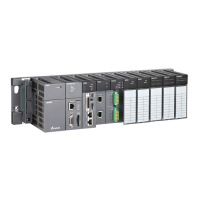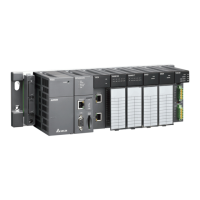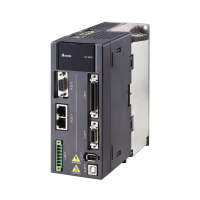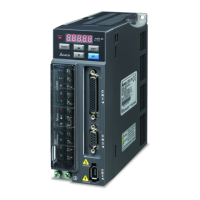AH500 Programming Manual
6-94
API
Instruction code Operand Function
0213 FBIN P
S, D
floating-point number into the
binary floating-point number
Device
X Y M S T C HC D L SM SR E PR K 16# “$” DF
Pulse instruction 32-bit instruction (5 steps) 64-bit instruction
AH500 AH500 -
Symbol:
S
:
Data source Double word
D
:
Conversion result Double word
Explanation:
1. The decimal floating-point number in the register specified by S is converted into the
single-precision floating-point number, and the conversion result is stored in the register
specified by D.
2. Suppose the value in S is 1234, and the value in S+1 is 3. The value in S is converted into
1.234x10
6
.
3. The value in D should be a single-precision floating-point number, and the values in S and S+1
represent the decimal real number and the decimal exponent respectively.
4. The instruction FBIN is used to convert the decimal floating-point number into the
single-precision floating-point number.
5. The real number of decimal floating-point numbers range from -9,999 to +9,999, the exponents
of decimal floating-point numbers range from -41 to +35, and the practical range of decimal
floating-point numbers in PLC is between ±1175×10-41 and ±3402×10+35. When the
operation result is zero, SM600 is ON.
Example 1:
When X0.0 is ON, the decimal floating-point number in the register in (D1, D0) is converted into the
single-precision floating-point number, and the conversion result is stored in (D3, D2).
Binary floating-point number
Decimal floating-point number
Exponent
Real number
Real number: 23 bits; Exponent: 8 bits; sign: 1 bit
Mathematical form
D 1 D 0
D 3 D 2
[D0] 10
X
[D1]
Example 2:
1. Before the floating-point operation is performed, users have to use the instruction FLT to
convert the binary integer into the single-precision floating-point number. The premise of the

